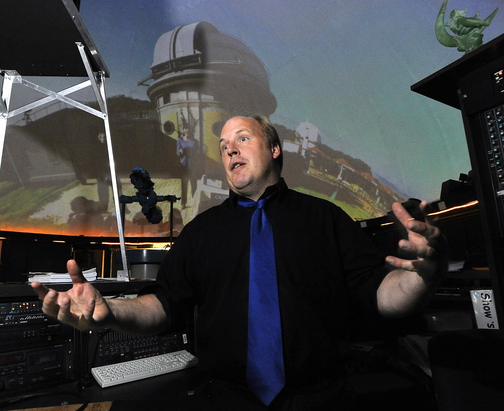Because of an editor’s error, an outdated version of Michael Stevenson’s Maine Voices Column was published in the Oct. 6 Maine Sunday Telegram and online. The correct version is published here.
GORHAM — “Higher education institutions face unprecedented challenges … To meet the challenges and adapt to changes, we need new models, new approaches, new practices. But more than anything else, we need new ways to think about priorities for our work.”
Disruptive change is happening across higher education, which includes all major public universities. The conversation I started with the USM physics faculty derives from this reality. (“USM says physics major is underused, will be cut,” Sept. 13).
I agree with the physics faculty and this newspaper’s editorial opinion (“Our View: Cutting physics major wrong budget solution,” Sept. 14) that physics is an important offering for our students. I am grateful to this newspaper, the community, and USM faculty for the passion they show for USM’s well-being.
The way to solve USM’s challenges – financial, enrollment, academic – is to face facts together and find creative, sustainable ways to serve our students and state. USM must develop new ways to provide transformational educational experiences, steward resources, be the intellectual hub and a cultural and economic driver of our region.
USM’s enrollments in specific areas are declining, as are enrollments in many colleges across the country. Maine’s traditional college-aged population is diminished.
Our student market – both traditional and a growing adult one – expects and deserves teaching and support services in formats that match today’s technology, career paths and demanding lives. USM, more than any other part of the University of Maine System, faces competition from other regional higher education institutions. USM cannot continue business as usual.
USM must allocate its funds in support of student needs and interests. We cannot afford to hold onto a vision of what a university should be if students do not support that vision with their time and tuition. We cannot simply designate a major as important and continue offering it regardless of student enrollments. Physics at USM annually enrolls 15 to 18 majors and graduates an average of four; courses designed for physics majors frequently attract four to eight students. In other science areas, some of which require instruction in physics, enrollments are robust and we are having difficulty keeping up with the demand.
Some may argue that we could cut non-academic costs in support of the physics major. From 2011 to 2012, USM eliminated 59 positions, 51 of which were staff positions. We still face fiscal challenges in 2013 and more than 63 percent of our budget resides in academic affairs.
The USM and wider community must engage in an honest discussion about how to develop and offer programs in which students want to enroll in numbers that will sustain the university. This week, we notified our faculty that we are taking steps to ensure that a more complete and open dialog takes place before any decisions are made. I have not asked the physics faculty to walk away from their discipline; I have asked them to help us integrate physics into a science program that will distinguish USM from our competitors and attract more students. In short, I want more students to become engaged in physics than is happening with the current major.
A USM community dedicated to service to students and our region, to creativity and collaboration, will sustain and prosper. The question is not what do faculty or university administrators want. Instead, the question is about what students want.
From market research we know that students want studies relevant to careers and personal growth offered in flexible formats. Cost and location matter. Employers want graduates competent in critical and creative thinking, self-direction, project management, teamwork and communication.
USM’s excellent faculty can teach those skills through programs attractive to today’s undergraduate and graduate students. The organization of academic programs to increase enrollment is a subject worthy of dialogue and timely realistic choices. I look forward to more of this conversation.
– Special to the Press Herald
Send questions/comments to the editors.



Success. Please wait for the page to reload. If the page does not reload within 5 seconds, please refresh the page.
Enter your email and password to access comments.
Hi, to comment on stories you must . This profile is in addition to your subscription and website login.
Already have a commenting profile? .
Invalid username/password.
Please check your email to confirm and complete your registration.
Only subscribers are eligible to post comments. Please subscribe or login first for digital access. Here’s why.
Use the form below to reset your password. When you've submitted your account email, we will send an email with a reset code.